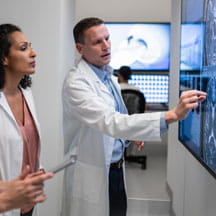Monroe Carell Jr. Children’s Hospital at Vanderbilt in Nashville has an evolving philosophy for its radiology department: look at it holistically, rather than as individual modalities and teams. This includes bringing staff into discussions on organizational decisions, and cross-training to provide new opportunities and support changing departmental needs. These strategies helped the children's hospital become a top performer in staffing efficiencies within radiology.
Cody Schmits, director of operations, and Catheryn Pasco, MBA, BS, R.T. (R) (M) RDMS, director of radiology, credit daily huddles with radiology staff, the operating room department, emergency department and the safety team in helping identify immediate and projected staffing needs. Monthly meetings with leadership and finance include reviews of trends in patient volumes. These practices have put a focus on daily operations for the entire department, versus individual modalities, avoiding complacency by constantly reevaluating how they work together for improved efficiency.
“You have to be able to move things around and have flexibility,” Schmits says. “We have to be proactive in our staffing and look ahead, see what’s coming and getting authorizations that you need. Those things in conjunction make it work.”
Using data to establish trust
To better identify staffing needs and establish trust with the team for staffing changes, the organization took an hourly look at patient volumes and staffing. Using six months of data, Schmits and Pasco showed the patient demand curve by identifying volume for each hour of the day. They overlaid that with the radiology department’s staffing model.
“We could show people what the demands are, where we’re overstaffed, where we’re understaffed and how we need to shift,” Pasco says. “It helped alleviate some of the anxieties because staff knew we’re trying to get them help where we’re understaffed.”
Monitoring volumes and staffing daily
During a daily staffing huddle at 7:45 a.m., each modality reports on volumes, patients and technologists available. Together, the group determines where additional support is needed and repositions staff accordingly. If volumes are low and don’t support the staff already scheduled, those with overtime are asked to reduce their hours first. Others who flex may use PTO or take unpaid time off and preserve their PTO bank, which often is not met with resistance.
“Most of the time, people are jumping at the chance to go home an hour early,” Schmits says.
As a general practice, Schmits and Pasco avoid 10- and 12-hour shifts and keep most staff on eight-hour shifts since it's easier to cover when a team member calls out unexpectedly. Weekends tend to have more 12-hour shifts due to a smaller pool of technologists who are willing to work weekends.
The team found PRN staff to be difficult to leverage for staffing shortfalls because many have low limits on how many days a month they work, which is where student technologists come in. Students in their last year of training are available to fill staffing shortages for certain tasks like portable chest x-rays.
On average, the radiology department asks team members to flex and reduce hours about once a week and taps into backup staff about three times per week. The team manages hours by reviewing the following day’s procedures and anticipated volumes so they can staff appropriately.
Cross-training for flexibility
Four out of five CT positions are cross-trained into diagnostic radiology, allowing for easy flexibility between the two modalities. The ultrasound team is not formally cross-trained, but staff float across all areas of radiology to perform basic skills that need little training.
“People are willing to pitch in whether it’s their primary modality or not,” Schmits says. “There are a lot of tasks that make things flow smoother that a technologists can do without being trained.”
It’s a practice that has worked its way into being a part of the regular schedule. Monroe Carell’s radiology department is backup for the Murfreesboro Diagnostic Center. The center does MRIs with sedation one day a week and a Monroe Carell radiology technologist helps.
Patient scheduling and throughput
Monroe Carell has a scheduling team just for radiology, coordinating scheduled appointments with clinic add-ons and walk-in patients. There are plans to add a self-scheduling component online so patients can schedule their own radiology appointments. Most patients receive an automated message as an appointment reminder, depending on the modality.
Radiology coordinates with the anesthesia team for procedures that require sedation, primarily for MRI appointments. CT and nuclear medicine have a lower need for sedation. The anesthesia team calls the patient or family ahead of their appointment as a reminder, answers questions, and screens the patient for COVID-19 symptoms.
Due to patient backlogs, additional magnets were added for MRI and hours of operation were modified to allow for patients to be brought in within three to five days, versus the 21-day average they were experiencing.




